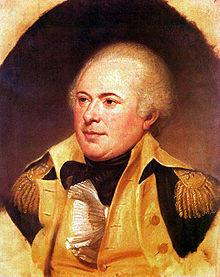
Back جيمس ويلكنسون (ضابط) Arabic James Wilkinson (Politiker, 1757) German James Wilkinson Esperanto James Wilkinson Spanish James Wilkinson Finnish James Wilkinson French James Wilkinson (politico) Italian 제임스 윌킨슨 Korean James Wilkinson Dutch James Wilkinson Portuguese
James Wilkinson (March 24, 1757 – December 28, 1825) was an American soldier, politician, and double agent who was associated with several scandals and controversies.[2]
He served in the Continental Army during the American Revolutionary War, but he was twice compelled to resign. He was twice the Senior Officer of the U.S. Army, appointed to be the first Governor of the Louisiana Territory in 1805,[3] and commanded two unsuccessful campaigns in the St. Lawrence River theater during the War of 1812. He died while seeking to serve as a diplomat in Mexico City.
In 1854, following extensive archival research in the Spanish archives in Madrid, Louisiana historian Charles Gayarré exposed Wilkinson as having been a highly paid spy in the service of the Spanish Empire.[4] In the years since Gayarré's research became public, Wilkinson has been savagely condemned by American historians and politicians. According to President Theodore Roosevelt, "[I]n all our history, there is no more despicable character."[5] However, he has been defended, especially in breaking up the Burr conspiracy.[6]
- ^ Montgomery, M.R. (2000). Jefferson and the Gun-Men: How the West Was Almost Lost. New York, NY: Random House. p. 284. ISBN 978-0-609-80710-1.
- ^ Linklater, Andro (2009). An Artist in Treason: The Extraordinary Double Life of General James Wilkinson. Walker Publishing Company. ISBN 978-0-8027-1720-7.
- ^ Bell, William Gardner (2005). "James Wilkinson". Commanding Generals and Chiefs of Staff: Portraits and Biographical Sketchs. United States Army Center of Military History. pp. 64–65. Archived from the original on 2021-04-10. Retrieved 2010-06-14.
- ^ "The Man Who Double-Crossed The Founders". Morning Edition. NPR. Retrieved 2017-04-04.
- ^ Stewart, David O. (2011). American Emperor. New York, NY: Simon & Schuster. p. 299. ISBN 978-1-4391-5718-3.
- ^ John Thornton Posey, "Rascality Revisited: In Defense of General James Wilkinson." Filson Club Historical Quarterly 74 (2000): 309-52.
© MMXXIII Rich X Search. We shall prevail. All rights reserved. Rich X Search
